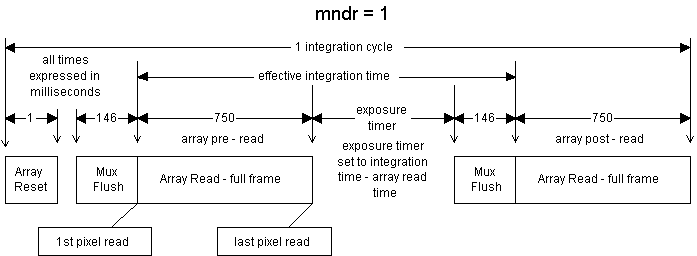 |
The readout of pixel data is accomplished by accessing each pixel individually and sampling the potential across a floating diode junction that is the pixel site. This process is non destructive in that the potential is not changed by the read operation. Pixel access is performed via an analog and digital module called the multiplexor. This complex electronic device is bonded to the photo-sensitive accumulation layer where the pixel sites (the diodes) are located on the sapphire substrate. The multiplexor interfaces the electronic signals from the array controller to access the pixel sites.
To accumulate photo-electrons, the pixel site must first be charged to a positive potential by a reset operation. This is accomplished by applying a clocking sequence to the multiplexor which injects potential into the diodes. Once the array is reset, photon generated electrons accumulate at the pixel sites and deplete the potential left by the reset operation.
To accurately determine the number of photo-electrons it is necessary to first sample the pixels and measure the potentials left by the reset process. This is the pre-read process and produces the first extension in a FITS data file . After an integration time when captured photons have produced electrons which have been accumulated in the pixel sites, the pixels are again sampled (readout) and the resultant data stored in the second FITS extension. This is the post-read process. Subtracting the pre-read from the post-read produces an image in which the bias, fixed pattern noise, and reset potential uncertainty are removed and the read noise multiplied by root two.
Before readout the multiplexor
contains spurious charge accumulated within the signal channels which needs
to be removed. This is done by performing a read operation on 64 columns
of the array but without sending data to the host. This removes the unwanted
charge which would otherwise appear as an exponential decay across the
quadrants in the column directions. Figure 1 shows schematically the described
process.
 |
Since the pixel signal is
readout non-destructively, it is possible to reduce the effect of read
noise when sky background limited images cannot be used. Since read noise
is predominantly white in character, by averaging a number of readouts
the noise can be reduced by root n where n is the number of readouts considered
in the average. This process is called multiple non destructive readout
(mndr). The mndr process can be implimented using the numreads command
on the acquisition system and is shown schematically in figure 2.
 |
Ingrid Software Version History.
|
|
|
|
|
|
|
|
|
|
|
|
|
|
|
|
|
|
|
|
|
|
|
|